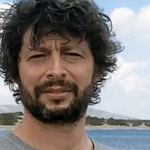Upper Candelaria River. Jungle area near the River bank, Mexico
2nd place in Biotope Aquarium Design Contest 2017

Volume: 576 litres
Dimensions: 160x 60 x 60 cm
List of fishes: 2 x Oscura heterospila, 7 x Poecilia Mexicana (female)
List of plants: N/A
Description of decorations: sand and fine gravel mix with a scattering of beech tree leaves. River boulders and cobbles, Wood is a mixture of locally collected beech and oak wood
Description of equipment: EHEIM classic 600 with both biological and mechanical filtration, 1 x Arcadia T8 38w freshwater lamp, EHEIM thermocontrol 250 heater
Water parameters: Temperature 27c- 80.6f, pH 7.5, Ammonia 0ppm, Nitrite 0ppm, Nitrate 20ppm, GH 18
Description of the area surrounding the biotope: The Rio Candelaria of Grijalva – Usumacinta region is in the Mexican state of Campeche in the southern part of the Yucatan peninsula and flows to the Gulf of Mexico. The River flows approximately 402 km through dense jungle and wetlands to the coastal zone, where it empties into the Laguna de Terminos, (a large brackish lagoon in western Campeche.) It is fed with the waters from the La Esperanza, Caribe, La Joroba and El Toro rivers. Most of the basin is in Mexico, although 50 km of channel extends into the Petén area of northern Guatemala.
Description of the underwater landscape of the biotope: Due to the size of the Rio Candelaria basin, there are many different biotope environments. Moderate flowing rivers flow over rock formations and into smaller jungle creeks. Some of the swamp regions in the upper River are still with lots of vegetation such as Nymphaea sp. and Typha (bulrush grass). The shallows in the tree lined jungle areas near the river bank will have lots of submerged wood and branches with lots of decaying leaf litter. Other areas near the banks may have aquatic vegetation such as Myriophyllum sp. The middle areas of the river are mainly sand/ rock and pebble substrate. I have chosen to represent a shallow quiet area for the spawning Oscura heterospila near the bank where there is submerged logs and branches. The substrate has a scattering of leaf litter upon the sand /gravel substrate, ideal for when the parents and fry forage for small food particles.
Description of the parameters of the habitat: Water can be both clear and turbid. The water is green in colour, with regular transparency and a depth of 8 meters. Not much information is available for water quality, however, due to the karst geology of the region, one can assume high values for alkalinity/hardness and pH values greater than 7.
List of fishes: Native cichlid species include: Cincelichthys pearsei, Cribroheros robertsoni, Oscura heterospila, Petenia splendida, Rocio octofasciata, Thorichthys helleri, Thorichthys meeki, Thorichthys pasionis, Trichromis salvini , Vieja bifasciata.
Introduced species: Parachromis managuensis.
Non cichlids: Astyanax aeneus, Hyphessobrycon compressus, Xiphophorus hellerii, Poecilia Mexicana, Gambusia sexradiata, Carlhubbsia kidder, Phallichthys fairweatheri, Belonesox belizanus, Rhamdia guatemalensis.
List of plants: Myriophyllum, Nymphaea spp, Typha (bulrush grass). Mangrove Towards the coast, where freshwater marsh merges
with brackish swamps.
Sources of information:
- Rivers of Mexico, Hudson et-al 2005 pp22-25
- Mexico a journey into the world of cichlids (Willem Heijns) video.
- Cichlid Room Companion website
- http://mundomaya.travel/en/
naturaleza/espacios-naturales/ item/rio-candelaria.html
Comments of the members of the jury of Biotope Aquarium Design Contest 2017

It’s a beautiful Candelaria biotope. The use of material in this tank is very accurate. The suitability and positioning of the selected materials is truly impressive, the aquarium has been functionally used up to the surface of the basin. The selected species belong to completely this habitat; they look very healthy and restful. A pair of Oscar Heterospila who looked after their babies had successfully emphasized the natural life and the social behaviour of the family. The information given about the habitat and the information sources are sufficient. It’s a biotope aquarium that is all but incomplete. Congratulations.

As seen on the video, fish are in excellent condition, coloration and spawning. That is a nature’s way of saying that everything is good. The decoration looks as on slowly moving area, and the leaves give it even more realistic presentation. Leaves are also good for fry.
This would be an amazing display tank in a public aquarium. Very clean, yet very natural-looking, large enough to allow the fishes to show all their natural behaviours, and also very well optically and aesthetically balanced (at least, in my opinion). I like the plain, beige background; it blends with the rest of the tank very well, making an impression of a large volume of slightly cloudy water.

Imagine yourself visiting Lee Nuttall’s home and when you open the door you see this biotope aquarium. For sure I would be in front of it with my mouth wide open, drooling, and wishing I had it in my living room! The way all the branches, sticks and leafs are cleverly placed give it a great esthetical but natural look. This aquarium shows us a great example of how to achieve a complex biotope look with simple natural elements.

What a beautifully composed biotope! This is a perfect demonstration that no aesthetic compromise is required to construct an authentic biotope. The branches look as though they have been arranged by the flow of the river, extending above the surface. Likewise, the leaf litter appears to have been piled up where the flow is gentler, in the sandy stretches. Smooth, rounded river cobbles complete the effect. The Oscura pair tend to their fry, showing their natural behaviours while the Poecilia forage on the outskirts of their territory, just as they would in the wild. The lack of aquatic plants is biotope-correct. My one note would be that it looks a bit too “fresh”, and needs time to mature with more algal growth, sediment, and biofilm on the branches and stones.

It is a highest range in aquarium design, as I think, the achievement of a harmonious picture using simple means. There are many options for how to put this driftwood, stones, branches, but obviously the best one is chosen. I know that 99% of aquarists, having received such decorations, would have made a common aquarium. And the author created one of the best entries of the contest. Exceptionally advantageous are the fish taking care of the fry. A touching family scene adds naturalness to the picture. And the author skilfully used it for his own purposes.
